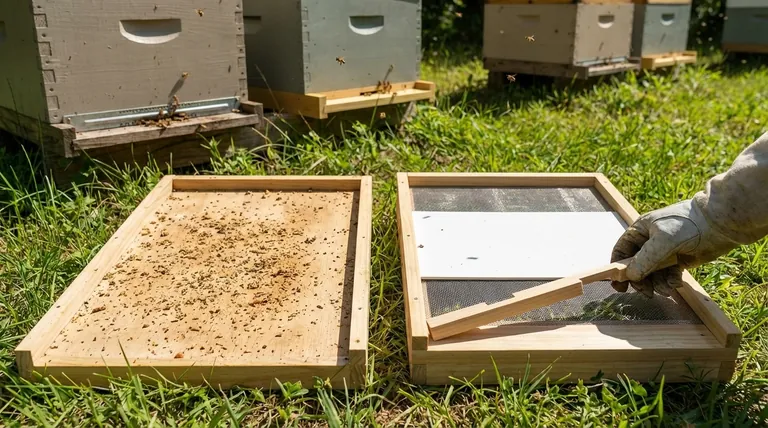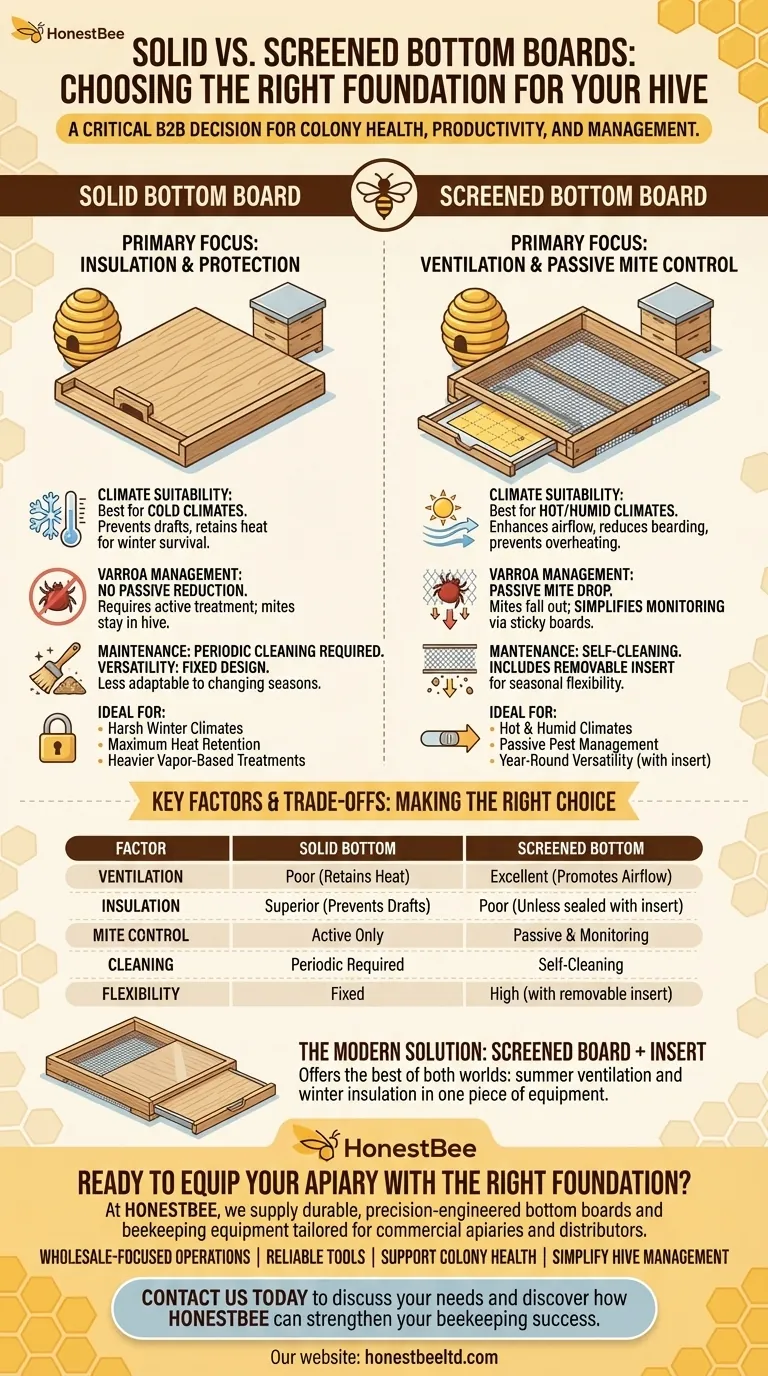Choosing the right foundation for your hive is a critical decision that directly impacts colony health and productivity. The choice between a solid and a screened bottom board depends primarily on your local climate, your pest management strategy for Varroa mites, and your preferred level of hands-on maintenance. Screened bottoms provide superior ventilation and passive mite control, while solid bottoms offer better insulation and protection from cold drafts.
The question is not which bottom board is universally "better," but which is the right tool for your specific climate and management goals. The modern screened bottom board with a removable insert often resolves this debate by providing the flexibility to adapt to changing seasons.

The Primary Function: Ventilation vs. Insulation
The most fundamental difference between the two styles is how they manage airflow and temperature, which has significant consequences for your colony.
Screened Bottoms for Superior Airflow
In hot or humid climates, proper ventilation is essential. A screened bottom board allows heat and moisture to escape, reducing the energy your bees must expend fanning to cool the hive.
This improved airflow helps prevent the colony from "bearding"—clustering on the outside of the hive—and keeps them focused on productive foraging.
Solid Bottoms for Heat Retention
In regions with cold winters, a solid bottom board provides a crucial advantage by preventing cold drafts from entering the hive from below.
This insulation helps the winter cluster maintain its core temperature more efficiently, conserving precious energy and honey stores. Some beekeepers also find that the warmer environment of a solid bottom encourages a slightly earlier brood build-up in the spring.
A Critical Factor: Varroa Mite Management
Your approach to controlling Varroa mites, the most significant pest in beekeeping, should heavily influence your choice.
Passive Mite Reduction with Screens
Varroa mites periodically fall off their honey bee hosts. With a screened bottom board, a significant percentage of these mites will fall completely out of the hive, unable to climb back up and re-infest another bee.
This passive removal can constantly lower the overall mite population within the hive, acting as a form of integrated pest management.
Simplified Mite Monitoring
Screened bottom boards are designed to be used with a removable insert, often called a "sticky board." By sliding this board in for a 24-48 hour period, you can easily conduct a "mite drop count."
This count gives you a reliable estimate of the infestation level in your hive, allowing you to make informed decisions about when treatment is necessary.
Understanding the Trade-offs
Neither option is without its drawbacks. Acknowledging them is key to making an informed choice.
Debris, Pests, and Cleaning
A solid bottom board will accumulate hive debris like wax cappings, pollen, and dead bees. This requires periodic cleaning by the beekeeper to prevent it from becoming a haven for pests like wax moths and small hive beetles.
A screened bottom is largely self-cleaning, as most debris falls through the mesh.
Unwanted Drafts
The primary disadvantage of a screened bottom is the potential for excessive drafts, especially during winter. A cold wind blowing underneath the hive can put significant stress on the winter cluster, even in moderately cold climates.
This is why most modern screened bottom boards come with a solid insert that can be used to close off the screen during cold weather.
Treatment Compatibility
Some mite treatments, particularly vapor-based ones like formic acid, are heavier than air. To be effective, they need to be contained within the hive for a specific duration.
Using these treatments requires a solid bottom or a screened bottom with its solid insert securely in place.
Making the Right Choice for Your Apiary
Ultimately, the best choice is the one that aligns with your climate and your goals as a beekeeper.
- If your primary focus is maximum ventilation and passive mite control (hot climates): A screened bottom board is your most effective tool and can be used year-round.
- If your primary focus is winter survival in a harsh, cold climate: A solid bottom board offers the best insulation, though a screened board with its winter insert provides the same benefit.
- If your primary focus is versatility and simplified management: The screened bottom board with its removable insert offers the best of both worlds, adapting from summer ventilation to winter insulation with one piece of equipment.
Your bottom board isn't just a floor; it's a critical tool for regulating your colony's health and environment.
Summary Table:
| Factor | Solid Bottom Board | Screened Bottom Board |
|---|---|---|
| Climate Suitability | Best for cold climates (insulates against drafts) | Best for hot/humid climates (enhances ventilation) |
| Varroa Mite Control | No passive mite reduction; requires active treatment | Passive mite drop; simplifies monitoring via sticky boards |
| Maintenance | Requires periodic cleaning of debris | Self-cleaning; debris falls through the screen |
| Versatility | Fixed design; less adaptable | Includes removable insert for seasonal flexibility |
Ready to equip your apiary with the right foundation?
At HONESTBEE, we supply durable, precision-engineered bottom boards and beekeeping equipment tailored for commercial apiaries and distributors. Whether you need solid boards for winter insulation or screened boards with inserts for year-round adaptability, our wholesale-focused operations ensure you get reliable tools that support colony health and simplify hive management.
Contact us today (#ContactForm) to discuss your needs and discover how HONESTBEE can strengthen your beekeeping success.
Visual Guide

Related Products
- Langstroth Screen Bottom Board for Beekeeping Wholesale
- Australian Pine Wood Langstroth Screen Bottom Board for Wholesale
- HONESTBEE Wooden Bee Escape Board with Triangle Mesh Design for Beekeeping
- HONESTBEE Professional Frame Wiring Board and Jig
- HONESTBEE Durable Frame Wiring Board with Integrated Tensioner
People Also Ask
- What are the benefits of a screened bottom board? Boost Hive Health & Control Varroa Mites
- What are the advantages of a screened bottom board? Boost Hive Health with Superior Ventilation & Pest Control
- How should the screened bottom board be used throughout the year? A Guide for Healthy Hives
- How does a screened bottom board assist with temperature control and pest management? A Key Tool for Modern Beekeeping
- What are the main benefits of using a Screened Bottom Board in beekeeping? Enhance Hive Health & Productivity



















